A small child requires constant care. All means for this should be provided by a children's first-aid kit for infants. It is necessary to form it before the birth of the baby - many components of the first-aid kit will be needed from the first days of life.
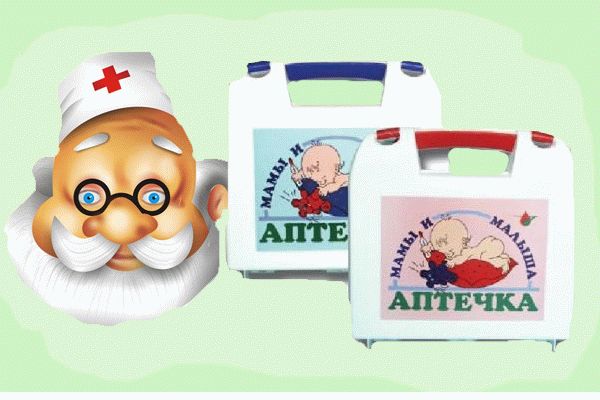
The composition of the children's first-aid kit must include:
- hygiene products;
- antiseptic disinfectants umbilical wound in the first days of life and for disinfecting the skin of the baby with wounds;
- necessary medical supplies for medical procedures;
- emergency medicine for a sick child.
Hygiene Products
- Baby bath soap. For convenience, you can purchase a liquid with a dispenser.
- Baby crease grease cream.
- Diaper rash cream - Bepanten, Purelan, Tsindol or D-panthenol (See in detail about diaper rash creams). These creams will help mom during treatment nipple cracks.
- Powder is used to prevent diaper rash before putting on a diaper. Do not use it at the same time with cream.
- Baby oil for massage.
- Vaseline oil for wetting cotton flagella when processing the nose and ears.
- Cotton wool for cleaning the ears and nose. To do this, roll up small flagella and clean the ear and nasal passages.
- Cotton buds are useful for treating umbilical wounds, pimples, and bites with antiseptics.
- Cotton buds equipped with a limiter to clean the auricle.
- Cotton pads for hygiene. You can use cotton wool instead, but it leaves particles of cotton on the skin.
- Wet wipes for quick care in an emergency.
Care Accessories
- Small scissors for cutting nails with rounded ends and a protective cap.
- An alcohol thermometer will help to measure the temperature of the water when swimming.
- Nasal aspirator to remove nasal discharge (see article on aspirators).
Medical instruments
- Thermometer for measuring temperature. It is safer to use an electronic thermometer, although the mercury gives more correct readings. (see article on all types of thermometers)
- Syringe number 1 on 25 ml for enemas. (how to make an enema for an infant)
- The vent pipe No. 1 for the removal of gases with intestinal colic. (how to use a gas outlet)
- Warmer to relieve abdominal pain.
- Pipette with a rounded end in a case (2 pcs.) For instilling drugs in the ears and nose.
- Bandage 2 pcs., One sterile, for dressings.
- Sterile wipes will be needed in the early days to treat the umbilical wound.
- Syringe dispenser or spoon with a dispenser for the introduction of drugs.
Antiseptics
- Hydrogen Peroxide 3%.
- A solution of brilliant green 1% 10 ml or an alcoholic solution of chlorophyllipt. The second option is characterized by the absence of burning sensation during the treatment of wounds, in contrast to brilliant green.
- Potassium permanganate (potassium permanganate) is needed to treat wounds: in the first days of the umbilical cord, then any other. It is better to buy it dry and make a 5% solution at home: dissolve 5 g in warm water (100 ml) and strain through cheesecloth in three layers. You can store the solution for 10 days. In the first month of a child's life, it is better to bathe in water with the addition of a light pink solution of potassium permanganate. This powerful disinfectant disinfects baby's delicate skin.
- Alcoholic solution of iodine 5%, 1 ml.
- Medical alcohol for disinfection.
- A bactericidal patch is used for skin damage.
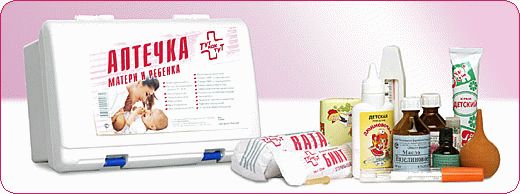
Medication
- A solution of vitamin D (Aquadetrim or Wigantol) for the prevention of rickets.
- Paracetamol antipyretic in suppositories or in liquid form (Efferalgan, Panadol, or Ibuprofen). It will be needed with a sharp increase in temperature. (temperature medicine)
- Antihistamine: Suprastin, Fenistil, Tavegil, Telfas or Claritin. It is necessary in case of an allergic reaction.
- Means for intestinal colic (Espumisan, Plantex). In children in the first months of life, the occurrence of intestinal colic is a very common occurrence. (Cure for colic)
- Activated carbon (sorbent) in capsules.
- The remedy for diarrhea (diarrhea) - Smecta, Linex.
- Medications for constipation - remedies for constipation.
- Drops from the common cold in the form of a spray (Nazivin, Aquamaris).
- Eye drops Albucid.
- Furacilin in tablets. Its solution will be needed when conjunctivitis occurs for washing the eyes and for washing the genitals of girls. (conjunctivitis in an infant)
- Interferon in the form of drops and nasal spray “NAZOFERON” to strengthen the baby’s immunity during the flu epidemic, as well as during the period of receiving the vaccination to reduce the risk of post-vaccination complications.
- Gel for relieving pain during teething - Denthol, Kamistad, Kalgel.
You can add herbal fees to a children's medicine cabinet for newborns. It is useful to add infusion of a string and chamomile to the water when bathing (herbs for swimming) They have a beneficial effect on the delicate skin of infants and relieve irritation. A decoction of dill or fennel seed will help relieve intestinal colic.
First aid kit storage
We divide the finished first-aid kit of the baby into two parts. The first, for everyday use, to keep on hand in a place easily accessible to parents. The other for emergency cases should be stored separately in a dark and dry place. Suppositories and ointments should be stored on the bottom shelf of the refrigerator.
The easiest way is to go to the pharmacy and buy a ready-made kit for caring for a newborn. True, such a set may not meet all the needs for child care. You may not need some funds, but you will have to buy missing ones separately. Therefore, it is best to make a list of everything you need and go to the pharmacy for a purchase. Of course, not all medicines are useful to the child, but they must be purchased in case of unforeseen situations.
1. “Ceficon D” or any suppository containing paracetamol - from temperature and pain.
2. Children's “Nurofen”.
3. Candles "Viferon" - increase immunity, are prescribed for colds, infections.
4. Candles “Viburkol” - a homeopathic remedy for high temperature, are prescribed when the teeth are cut.
5. Furacilin - antibacterial tablets for rinsing, rinsing.
6. Dry baby cough syrup.
7. “Physiomer” or “Aquamaris” or “Aqualor” - seawater solutions for washing the nose.
8. Aspirator.
nine.Nazivin for babies is a vasoconstrictor for the common cold.
![]() For skin
For skin
10. Hydrogen peroxide (handle the navel, scratches, etc.).
11. Zelenka (for processing the navel in liquid form, for scratches, etc. - pencil “Lecker”).
12. Chlorophyllipt (lubricate acne, inflammation, add to the bath when bathing).
13. Potassium permanganate - bathe a child in the first days after the hospital.
14. Ointment “Bepanten” - lubricate cracks, irritations, dry skin.
15. Dropalen ointment - in case of irritation, sweating, diaper rash.
16. Zinc paste - excellently combats sweatshirts.
17. Calendula tincture / Calendula ointment - lubricate scratches, irritations.
18. “Fenistil” gel - from allergic skin manifestations, insect bites.
19. Ointment “Rescuer” - bruises, burns, scratches, bites, etc.
20. Ointment “Arnica” - bruises, bruises, bruises.
21. Alcohol napkins.
22. Hemostatic napkins.
![]() For the tummy
For the tummy
23. “Baby Kalm” - drops from colic-gazik (on grass).
24. “Sub Simplex” - drops from colic-gaziks (the active substance is smectin).
25. Tea “Plantex” (attention: few people read the instructions, but this tea should not be given to children with lactose deficiency!)
26. Klizmochki with a soft tip No. 1 and No. 2 (to let out gases, use instead of an aspirator and directly for enemas).
27. Glycerin candles - use for constipation (for babies - 1/7 part, it is well cut with a thread).
28. “Microlax” - microclysters, very convenient to use, also used for constipation (half of the tube is introduced for babies).
29. “Dufalac” - from constipation, can be taken from birth.
30. “Regidron” - restores the body's need for fluid in case of diarrhea and vomiting.
31. “Smecta” - with diarrhea, upset stomach.
32. Vent pipe - for “farting” (difficult to get).
![]() For eyes
For eyes
33. Ointment tetracycline eye.
34. Drops of chloramphenicol ophthalmic (these two options are just from the category of “cheap” drugs, which may not be in the nearest pharmacies).
![]() Herbs
Herbs
35. Chamomile is an anti-inflammatory agent, relieves spasms, and is used internally and externally (baths, washing).
36. Mint - relieves nausea.
37. Calendula is an external anti-inflammatory agent.
38. A series - anti-allergic weed, for internal use and bathtubs.
39. Motherwort - a sedative, can be added to the bath.
40. Bay leaf - just like a series, it fights with allergic manifestations.
![]() General
General
41. “Fenistil” drops are anti-allergic (if they are not needed in the current regimen, it will be required for vaccination).
42. “Kalgel” - gel with lidocaine, reduces pain from teething.
43. Thermometer in the room, a thermometer in the bath, a thermometer for measuring body temperature. Now very convenient infrared thermometers are sold, which measure very accurately the temperature of both the body and the air in the room.
44. Pieces of 5 pipettes with a blunt end (5 - because they tend to disappear somewhere).
45. Children's plasters.
46. Measuring spoon or glass for dosage of drugs.
47. A silver spoon (it is better to drink with water from just such a one, silver really has a beneficial effect on what it concerns).
48. Children's urinal (it is very convenient to collect urine for analysis: a small plastic bag simply sticks safely to the skin of the baby under the diaper).
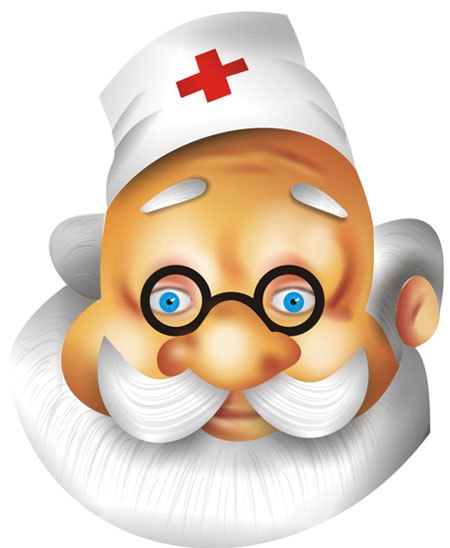
Yet:
- Baby creams (types and how to choose a baby cream);
- TOP 10 baby care products.
Video: First-aid kit for a newborn. What do you need to buy first?
The composition of the first-aid kit from Lara's mom:

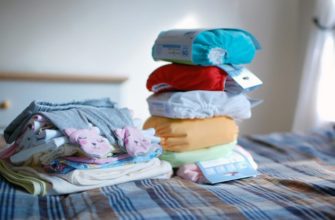

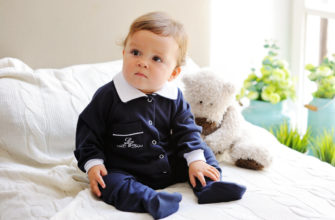
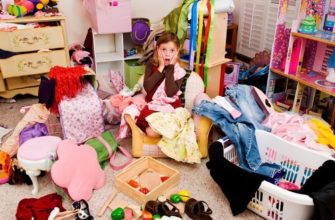
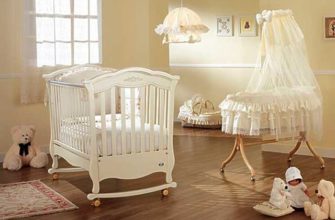
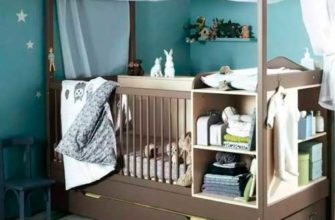
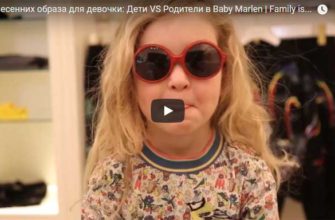
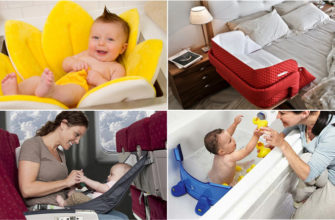
Indeed, the article is very useful and relevant. It is better to take care of the acquisition of such a first-aid kit in advance. And it’s very good that it describes where and how to store the contents of such a first-aid kit. And dividing it into two parts is also very reasonable advice.
Everything is very detailed, thanks! I quickly collected everything I needed on the pharmacy.ru website, I recommend it!
Seriously? green in 2019? I generally am silent about the potassium permanganate; it has long been illegal for us ... a very outdated article. 15-20 years ...
Denis, what’s wrong with the greenback ???